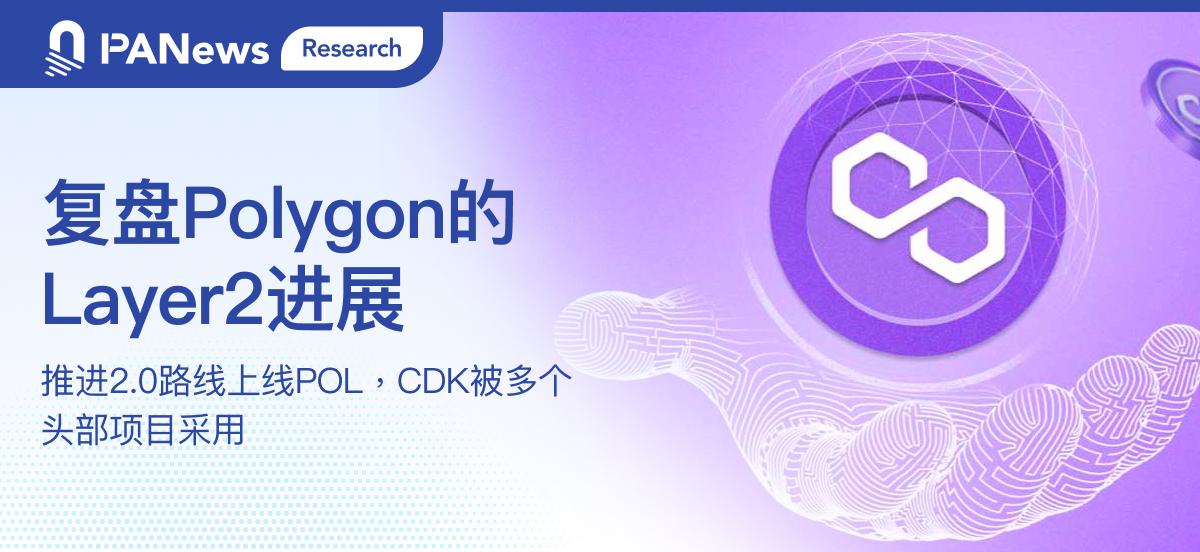Author: Nancy, PANews
The Polygon 2.0 plan is accelerating. On October 25th, Polygon Labs announced the successful deployment of the new token contract POL on the Ethereum mainnet, which means that the native token MATIC will soon undergo an actual upgrade. This upgrade is also an important milestone in building the internet value layer for Polygon 2.0.
In the past few months, Polygon has successively released multiple products and proposals to empower Polygon 2.0 and make new progress, while the frequent departure of executives has also raised suspicions.

Launching Polygon 2.0, New Token Contract Deployed on Ethereum Mainnet
"After months of development, community consultation, and testnet launch, the upgrade of POL has been initiated on the Ethereum mainnet," Polygon Labs announced, stating that POL is the next-generation highly productive token that will provide power for the Layer2 ecosystem based on zero-knowledge technology through native re-collateralization protocol. This protocol allows POL holders to validate multiple chains and perform multiple roles on each chain (sequencing, ZK proof generation, participating in data availability committees, etc.).
The announcement also pointed out that the POL upgrade is also preparing for the next milestone in the Polygon 2.0 roadmap, which includes launching a new staking layer to support Polygon L2, upgrading Polygon PoS to zkRollup, and implementing advanced, ZK-driven interoperability and shared liquidity protocols for all L2. However, at this stage, users do not need to take any action and should wait for further official announcements in the future.
In fact, Polygon 2.0 is an upgrade plan announced by Polygon in June this year, which includes four contents: Polygon PoS upgrade, technical architecture upgrade, token economy update, and governance mechanism upgrade, aiming to become a unified network of L2 chains supported by ZK technology to establish the value layer of the internet, allowing users to create, exchange, and program value. Among them, the token POL is an important part of the Polygon 2.0 roadmap. Compared with the original token MATIC, its most important feature is cross-chain interoperability, which can be used on all chains in the ecosystem, and holders can become validators to maintain network security and receive rewards.
In September of this year, Polygon Labs proposed three improvement proposals (PIPs), among which PIP-18 proposed the implementation of the POL token to replace the existing MATIC token as the native gas and staking asset of the Polygon ecosystem.
According to the official release of the new token POL's economic model whitepaper, POL is defined as the third-generation token after BTC and ETH, and will operate within all Polygon ecosystem networks, including Polygon PoS, Polygon zkEVM, and Polygon Supernets. The initial total supply of POL is 10 billion, and it will increase at a constant rate of 2% per year for the next 10 years. Whether the issuance rate will be adjusted after 10 years will depend on the specific situation, but it will not exceed 2%. The initial supply will be used for MATIC upgrade exchange, i.e., MATIC holders will exchange it at a 1:1 ratio for POL, and the additional issuance will be used for validator rewards and ecosystem support. To ensure that holders have sufficient time to make the conversion, Polygon proposes to set a grace period of at least four years to complete the upgrade process.
It is worth mentioning that the issuance mechanism of the new token also once caused dissatisfaction among MATIC holders, as the total amount of POL after issuance will exceed the maximum supply of MATIC, which will dilute the value of the original token. In response to this, the official stated that this issuance strategy is the best solution for the entire Polygon ecosystem, achieving a balance between ecosystem support and token dilution.
"The ultimate goal of Polygon 2.0 is to solve the liquidity unification and elastic expansion problems of the application chain built on it. Liquidity unification means that users of the ecosystem can use any application chain without any sense of difference, and elastic expansion means that if a chain suddenly has a large transaction volume, idle resources must be transferred to avoid resource waste. If you want to smoothly achieve the above effects, you need 'initial heavy collateral,' such as allowing ETH to be staked in addition to Ethereum to achieve the effect of staking other protocols at the same time for more profits. Therefore, Polygon naturally cannot let each chain stake separately, otherwise, it will generate a large amount of idle resource waste, so it directly unifies the collateral at the initial layer and then dynamically allocates resources to the upper application chain," said researcher @陈剑Jason on social media X, explaining the reason for Polygon issuing POL.
While Polygon is vigorously advancing its new roadmap, it is facing many challenges itself. In addition to MATIC being defined as a security in the SEC's lawsuits against Binance and Coinbase, there are regulatory risks, and the management has also undergone frequent changes.
Since the beginning of this year, after Polygon Labs announced a 20% reduction in staff, several executives have successively announced their resignations. In March of this year, Polygon co-founder Anurag Arjun resigned and acquired the modular blockchain project Avail; subsequently, Polygon's research head Prabal Banerjee also announced his resignation and joined Avail as a co-founder; in July, Polygon Labs underwent a senior management reshuffle, with President Ryan Wyatt resigning and serving as an advisor, and Chief Legal Officer Marc Boiron being promoted to CEO; in October, Polygon co-founder Jaynti Kanani announced his departure, stating that he had decided to leave "daily work" before June, but he still has confidence in Polygon's future and community.
Among them, Anurag Arjun and Jaynti Kanani are two of the three original founders of Polygon, and their departure has raised many suspicions, but their names are still retained on the official website. In response, Sandeep Nailwal once responded that Polygon currently has about 10 co-founders. Anurag (Arjun) and JD (Kanani) built the first generation of Polygon, which is a sidechain. Without their leadership and technical foresight, Polygon would not have achieved its current success. However, the market is currently shifting towards ZK, and the other co-founders of Polygon are experts in this area, and from a technical perspective, they can make more contributions. But JD and Anurag may not be the most suitable candidates to contribute to Polygon's development in the ZK direction at this stage."

Co-founder lineup on Polygon's official website
Accelerating the Construction of the Layer2 Ecosystem, Polygon CDK Becomes a "Mainstream" Choice
Layer2 has become the mainstream narrative of the crypto market. It is natural for Polygon to shift to ZK. Before the formal transformation, Polygon already had rich technical and practical reserves.
In March of this year, Polygon launched Polygon zkEVM. Although Polygon zkEVM is the second zkEVM to go live on the mainnet after the zkSync Era, according to L2Beat data, Polygon zkEVM ranks seventh among ZK solutions and only accounts for 0.57% of the L2 market share.
Faced with the overwhelming competition from similar competitors and the huge traffic in this field, Polygon announced the launch of the Polygon 2.0 upgrade plan after a three-month hiatus. Especially in the past few months, Polygon has been continuously focusing on governance mechanisms, token economics, and other aspects around Polygon 2.0.
In July, Polygon announced plans to completely reform its governance framework in the Polygon 2.0 roadmap to achieve more decentralized control. This includes the launch of an "ecosystem committee" for smart contract upgrades and the introduction of a two-stage community treasury to fund ecosystem projects. The new governance model will form the "three major governance pillars," focusing on core protocol governance, smart contract governance, and community treasury governance. Other key features include the expansion of the Polygon Improvement Proposal (PIP) framework, the introduction of an "ecosystem committee" for system smart contract upgrades, and the two-stage community treasury governance to provide funding for promising ecosystem projects.
At the end of August, Polygon Labs released a software tool called Chain Development Kit (CDK), which allows developers to build second-layer chains supported by zero-knowledge proofs for Ethereum. The second-layer blockchain deployed using CDK will be able to connect to a shared ZK bridge, enabling interoperability. The CDK codebase will be open source. This tool will also be provided as part of the Polygon 2.0 roadmap set to be launched next year, aiming to provide a framework for developing second-layer blockchains that can run on the Ethereum network.
Polygon CDK competes with OP Stack, which is the most widely adopted ZK solution with a first-mover advantage. Since its launch, Polygon CDK has attracted many well-known projects, such as Immutable zkEVM, Aavegotchi, Astar, and Dogechain, and even Manta has chosen to migrate from OP Stack to Polygon CDK. (Related reading: Building zk Layer2: Inventory of 13 Ecosystem Projects Based on Polygon CDK)

Upcoming large-scale projects using Polygon CDK
In September, Polygon released three proposals regarding the 2.0 upgrade and POL token migration. In addition to the previously mentioned PIP-18, PIP-17 outlines the "Phase 0" of Polygon 2.0, mainly ensuring that end users and developers do not need to take any action on the existing Polygon PoS and Polygon zkEVM chains during the upgrade period. PIP-19 requires the native Gas token on Polygon PoS to be upgraded from MATIC to POL in a way that ensures maximum backward compatibility, ensuring that the upgrade to the new token does not change the compatibility of the smart contracts on Polygon PoS. The goal here is to ensure that the code attributes of the upgraded POL token remain unchanged.
In October, Polygon Labs released and officially launched the open-source gateway "Chain Indexer Framework" for building scalable dApps. This framework helps users develop scalable dApps, seamlessly handle blockchain events, and achieve real-time EVM chain data integration. Recently, the Polygon forum initiated the PIP-29 proposal to establish a decentralized governance committee, which introduces a protocol committee governance structure responsible for regular and emergency upgrades to system smart contracts, i.e., Polygon protocol components implemented as smart contracts on Ethereum. The proposal also suggests that the protocol committee will manage all future system smart contracts for Polygon 2.0 on behalf of the community and has appointed the first 13 members.
In the competition of new public chains, Polygon has secured a place with strong resource integration and marketing capabilities. In the midst of the fierce battle in the Layer2 track, whether Polygon 2.0 can gain a foothold, ecosystem resources and performance will be key factors.
免责声明:本文章仅代表作者个人观点,不代表本平台的立场和观点。本文章仅供信息分享,不构成对任何人的任何投资建议。用户与作者之间的任何争议,与本平台无关。如网页中刊载的文章或图片涉及侵权,请提供相关的权利证明和身份证明发送邮件到support@aicoin.com,本平台相关工作人员将会进行核查。




